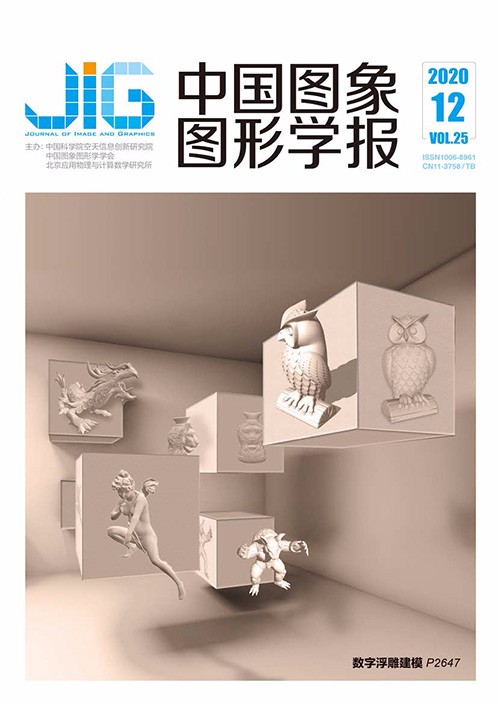
联合聚焦度和传播机制的光场图像显著性检测
摘 要
目的 图像显著性检测方法对前景与背景颜色、纹理相似或背景杂乱的场景,存在背景难抑制、检测对象不完整、边缘模糊以及方块效应等问题。光场图像具有重聚焦能力,能提供聚焦度线索,有效区分图像前景和背景区域,从而提高显著性检测的精度。因此,提出一种基于聚焦度和传播机制的光场图像显著性检测方法。方法 使用高斯滤波器对焦堆栈图像的聚焦度信息进行衡量,确定前景图像和背景图像。利用背景图像的聚焦度信息和空间位置构建前/背景概率函数,并引导光场图像特征进行显著性检测,以提高显著图的准确率。另外,充分利用邻近超像素的空间一致性,采用基于K近邻法(K-nearest neighbor,K-NN)的图模型显著性传播机制进一步优化显著图,均匀地突出整个显著区域,从而得到更加精确的显著图。结果 在光场图像基准数据集上进行显著性检测实验,对比3种主流的传统光场图像显著性检测方法及两种深度学习方法,本文方法生成的显著图可以有效抑制背景区域,均匀地突出整个显著对象,边缘也更加清晰,更符合人眼视觉感知。查准率达到85.16%,高于对比方法,F度量(F-measure)和平均绝对误差(mean absolute error,MAE)分别为72.79%和13.49%,优于传统的光场图像显著性检测方法。结论 本文基于聚焦度和传播机制提出的光场图像显著性模型,在前/背景相似或杂乱背景的场景中可以均匀地突出显著区域,更好地抑制背景区域。
关键词
Saliency detection on a light field via the focusness and propagation mechanism
Li Shuang, Deng Huiping, Zhu Lei, Zhang Long(Information Science and Engineering, Wuhan University of Science and Technology, Wuhan 430081, China) Abstract
Objective Saliency detection, which has extensive applications in computer vision, aims to locate pixels or regions in a scene that attract the visual attention of humans the most. An accurate and reliable salient region detection can benefit numerous vision and graphics tasks, such as scene analysis, object tracking, and target recognition. Traditional 2D images focus on low features, including color, texture, and focus cues, to detect salient objects from the background. Although state-of-the-art 2D saliency detection methods have shown promising results, they may encounter failure in complex scenes where the foreground and background have a similar appearance or where the background is cluttered.3D images provide in-depth information that benefits saliency detection to some extent. However, most of 3D saliency detection results greatly depend on the quality of depth maps; in this way, an inaccurate depth map can greatly affect the final saliency detection result. Moreover, 3D saliency detection methods may produce inaccurate detection when the salient object cannot be distinguished at the depth level. The human visual system can distinguish regions at different depth levels by adjusting the focus of eyes. Similarly, light field has a focusing capability where a stack of images that emphasize different depth levels can be stacked. The focus cue supplied by a focal stack helps determine the background and foreground slice candidates or those conditions with certain complexities (i.e., the foreground and background having similar color/textures). Therefore, focus can improve the precision of saliency detection in challenging scenarios. The extant light field saliency detection methods verify the effectiveness of integrating light field cues, including focus, location, and color contrast cues. From the above discussion, an important aim of saliency detection for a light field is to explore the interactions and complementarities among light field cues. Method This paper builds a foreground/background probability model that can highlight salient objects and suppress the background by using location and focus cues. A propagation mechanism is also proposed to enhance the spatial consistency of the saliency results and to refine the saliency map. The focal stack and the all-focus image are taken as light field input images that are segmented into a set of non-overlapping super-pixels via simple linear iterative clustering (SLIC). First, we detect the in-focus regions of each image in the focal stack by applying the harmonic variance measure in the frequency domain to define our focus measure. Second, to determine the foreground image set and background image, we scale the focus of the focal stack by using a Gaussian filter. Saliency detection follows a common assumption that salient objects are more likely to lie at the central area and are often photographed in focus. Therefore, we analyze the distribution of in-focus objects with respect to their prior location by using a 1D band-pass Gaussian filter and then compute the foreground likelihood score of each focal slice. We choose the slice with the lowest foreground likelihood score as our background slice and the slice whose likelihood score is 0.9 times higher than the highest reported foreground likelihood score as our foreground slice. Afterward, we construct a foreground/background probability function by combing the focus of the background slice with the spatial location. We then compute the foreground cue from the foreground slice candidates and the color cue on the all-focus image. To enhance contrast, we use the foreground/background probability function to guide the foreground and color cues, which we use in turn to obtain the foreground and color saliency maps, respectively. From these maps, we find that the low saliency value of a salient object can be improved and that the high saliency value of the background area in complex scenarios (e.g., where the foreground and background are the same) can be restrained. We combine the foreground and color saliency maps by using a Bayesian fusion strategy to generate a new saliency map. We then apply a K-NN enhanced graph-based saliency propagation method that considers the neighboring relationships in both spatial and feature spaces to further optimize this saliency map. Optimizing the spatial consistency of adjacent super-pixels can uniformly highlight the saliency of objects. We eventually obtain a high-level saliency map. Result We compare the performance of our model with that of five state-of-the-art saliency models, including traditional approaches and deep learning methods, on a leading light field saliency dataset(LFSD). Our proposed model effectively suppresses the background and evenly highlights the entire saliency object, thereby obtaining sharp edges for the saliency map. We also evaluate the similarity between the predicted saliency maps and the ground truth by using three quantitative evaluation metrics, namely, canonical precision-recall curve (PRC), F-measure, and mean absolute error (MAE). Experiment results show that our proposed method outperforms all the other methods in terms of accuracy (85.16%). F-measure (72.79%), and MAE (13.49%). Conclusion We propose a light field saliency detection model that combs the focus and propagation mechanisms. Experiment results prove that our saliency detection scheme can efficiently work in challenging scenarios, such as scenes with similar foregrounds and backgrounds or complex background textures, and out performs the state-of-the-art traditional approaches in terms of precision rates in PRC and false positive rates in MAE.
Keywords
saliency detection light field image focus probability function of foreground/background propagation mechanism spatial consistency
|



 中国图象图形学报 │ 京ICP备05080539号-4 │ 本系统由
中国图象图形学报 │ 京ICP备05080539号-4 │ 本系统由